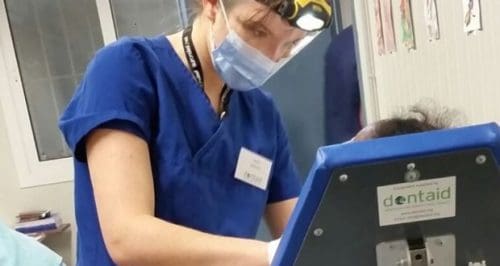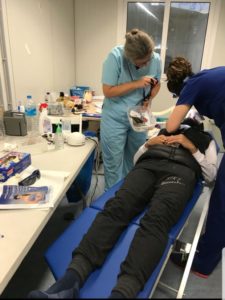
Daisy McCarthy at work in the clinic in Lesvos.
The camp was imposing with its huge fences bristling with razor wire. I kept my sunglasses on and my head down as we made our way to the makeshift clinic. The walkway was crammed with tents to accommodate families that had recently arrived. Washing and bedding was strung across windows, and parents kept one eye on their children and the other on us.
I arrived in Moira camp on the Greek island of Lesvos last October as part of a dental outreach team for refugees who’d recently landed from Turkey by boat, six kilometres across the Adriatic Sea. Originally a prison, and subsequently designed as a temporary shelter to accommodate up to 4,000 refugees, the camp’s population had swollen to over 8,000.
In the daytime, the scene resembled a busy airport where extreme weather had grounded all flights. It was swarming with children and parents trying to keep order amongst the chaos. Recent arrivals queued for information about how to work through the system to move onwards to Europe, while others maintained daily ablutions: meals and finding power sources for their phones.
What had made me go there? The visceral reaction I had when I saw the photograph of the body of Alan Kurdi, the three-year-old Syrian child lying dead on a Turkish beach in September 2015.
Having volunteered as a dentist previously in other parts of the world, the thought of carrying out basic care with limited facilities wasn’t daunting. But by the time I landed in Greece, public sentiment about the refugee crisis was changing. Refugees had become known as “migrants” in media parlance, and politicians warned us about their “flooding” and “swarming” to our shores. Motives were questioned.

Clinic
Our clinic was a dark prefab without running water, with pressure cookers for sterilisation and headlamps to assess patients. We treated more than 150 people over the course of the week: all had an urgent need for dental treatment, and few spoke English. We muddled through via a combination of sign language and Google Translate.
As we worked we got to know the people such as the family in the tent just outside our clinic, who had a UNHCR storm kettle and made us tea every afternoon.
We got to know the man who lost his heart medication overboard when his boat had capsized on the journey to Lesvos, and the 20-year-old Afghan who came to the clinic on the first day to translate for his friend. He’d been in the camp for 18 months, and had taught himself English in that time. When he saw us struggling to communicate with other Afghan families, he offered to translate.
On the fifth day he developed a toothache himself. As I worked to extract the offending tooth, he stopped me twice; not from nerves, but in order to translate for an Afghan family he overheard in the clinic. Afterwards, with a mouth full of gauze, he stayed on to continue his services, and was waiting for us every morning for the remainder of our time there.
My previous experience of dental volunteering was in highly deprived areas in Africa, where resources are so limited that patients in need rushed enthusiastically to us to relieve their pain through extraction; it was the only option they had and they knew it.
In Moira, it was different. Most, hailing from Syria, Afghanistan, Eritrea and Cameroon, had come from lives where regular dental check-ups were the norm. They knew that when you had toothache, extraction wasn’t the only option. They didn’t want charity, they didn’t want an extraction for the sake of pain-relief, or because they may never see a dentist again. Half of the people with dental abscesses we saw opted not to have their tooth out because they still wholeheartedly believed that their situation was only temporary.
There were lighter moments. Inflated dental gloves became the toy du jour. On my final day, I felt a tug on my scrubs mid-extraction: a little boy told me via very effective sign language – and no uncertain terms – that a balloon was needed right now.
Smiles
As the days passed, I grew more comfortable in my surroundings, and began to slow my walk to and from the clinic. I made eye contact with everyone who looked at me, and smiled shyly. Every smile was returned. And with each smiling nod, the notion that the refugees were an “other” to be apprehensive about became increasingly illogical.
These smiles warmed me, but I wished we had a common language. I wanted desperately to say “welcome”, and to wish them a safe onward passage. I wanted to say I knew I had absolutely nothing to fear. That I could see that they didn’t want anything from me, that they just want a place to call their own, and the opportunity to build a safe life for themselves and their loved ones.
What haunted me after I left Greece was the knowledge of what would most likely greet them when they reached their final destination. What bureaucratic and attitudinal blockades would prevent them from re-entering a “normal” life? In Moira, the hope was more palpable than the trauma: what would be left if that hope was shattered, if after the longest and most difficult of journeys, they are not granted a safe place to call home, and an opportunity to be valued once more.
I went to a refugee camp at the doorstep of Europe preparing to salve the guilt of my own privilege by spending a week with those in need of dental care. Instead, I came face to face with ordinary people like you and I.
The enormity of the refugee crisis can feel too difficult to think about, and too hopeless to try to resolve.
But we can reach out towards the new arrivals on our shores. Though we are nervous, we can make eye contact and a start a conversation. We can turn the cliché of an Irish welcome into a truth. And in years to come, when our children ask us about this very dark period in global history, we can look them in the eye and tell them we were there. And that one human connection at a time, a bridge of tolerance and inclusion helped us to walk towards an Ireland and a world where no human is illegal.
Article published in the Irish Times 5th Nov 2018 online edition. Link to article; here.
